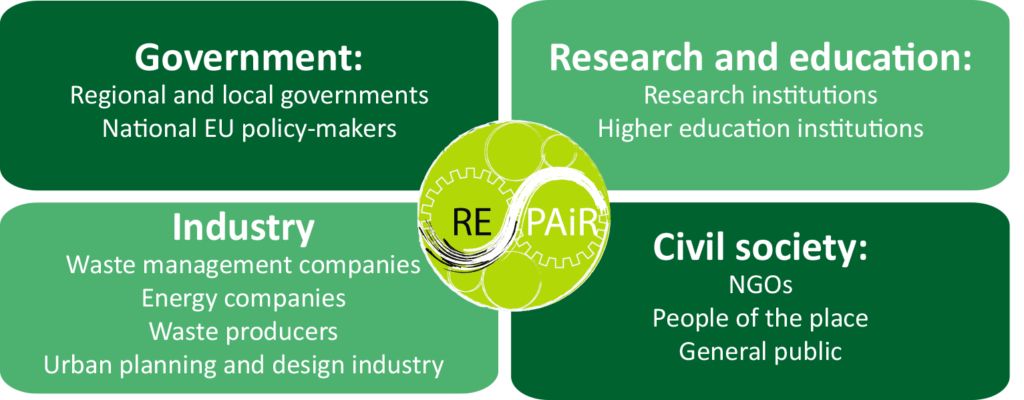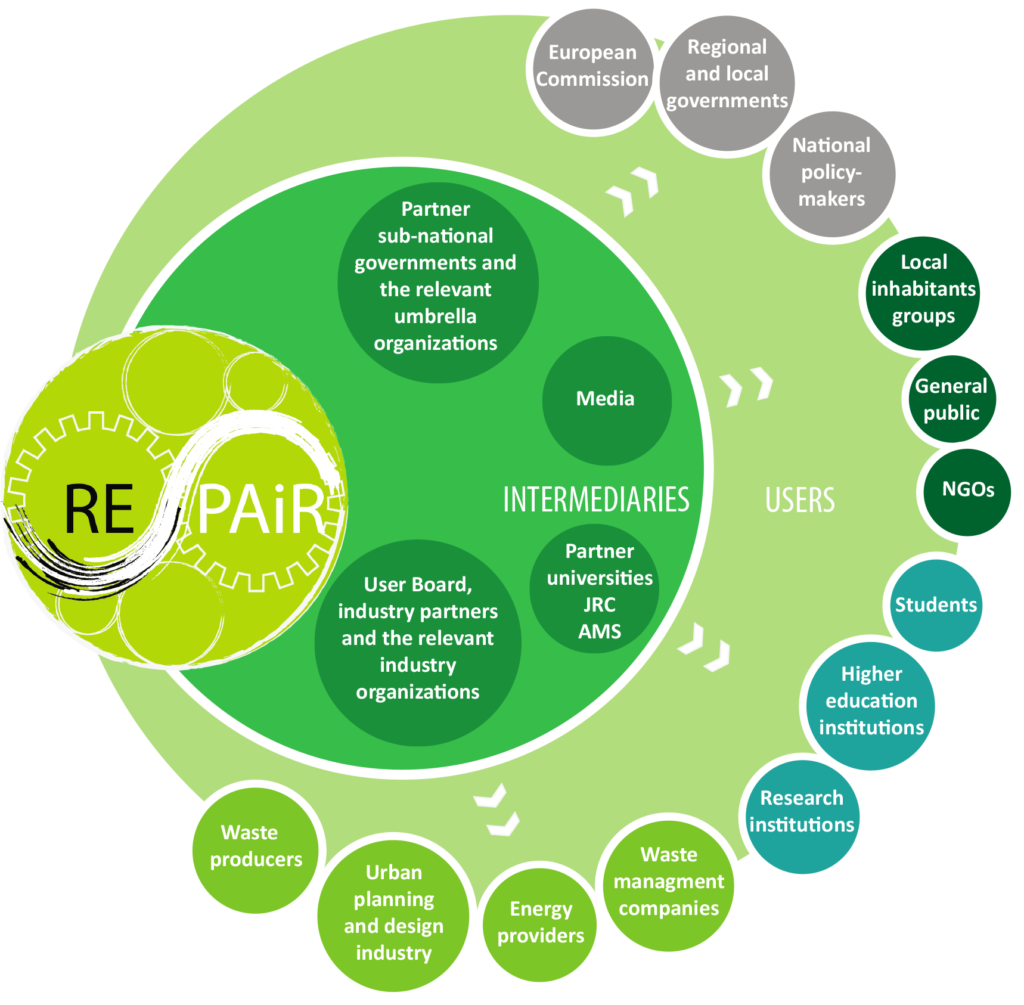The outcomes of REPAiR will be of relevance and use to a wide variety of stakeholder groups. The strategy to ensure stakeholder uptake of the projects results and developed tools is based on three elements:
- Careful and strategic mapping of REPAiR’s stakeholders’ landscape to identify groups of end users of the project’s outputs;
- Outreach measures tailored to the different target groups to encourage them to use REPAiR’s outputs in their own activities and distribute these in their networks;
- A comprehensive representation of those groups within the consortium and outreach to their peers.
REPAiR’s main stakeholder groups.
Four groups of stakeholders were identified as the Lead Users of the GDSE and the related tools: (1) regional and local authorities; (2) industry stakeholders in the waste management sector and related fields; (3) national and EU policy-makers dealing with waste management, environmental protection, etc.; and (4) social.
The first group, regional and local authorities interested in enhancing waste management within their territories, yet struggling with the complexity of this public task, and involvement of private partners, are expected to take the GDSE. The latter will offer a useful, comprehensive and fully customizable decision-support toolkit based on an integrated and collaborative approach to urban metabolism and relevant feedback loops. More specifically, the GDSE will be of particular interest for the regional and local officials in charge of spatial planning, environmental policy, waste management and energy policy. Their direct involvement in the development of the GDSE and, subsequently, in its application within the six case study areas to address the place-specific challenges formulated by themselves, in collaboration with the other stakeholders involved in REPAiR, will ensure that the toolkit matches their needs and create a sense of ownership of it, which in turn will increase the likelihood of further uptake of The GDSE in their practice beyond REPAiR. The co-development of the GDSE by these officials will also secure that the tool will be relevant, accessible and attractive for users within regional and local public authorities in other urban regions across Europe.
Secondly, the GDSE will also be of interest to relevant industries like:
The GDSE, being an open source platform, will offer the relevant businesses a possibility to adapt it to different uses and/or enhance it to improve its usability in different contexts. The GDSE will thus offer businesses in waste-related industries an attractive and adjustable tool for improving their own practices (reducing waste generation, enhancing waste treatment, promoting recycling of materials, re-using of waste to produce energy, etc.) as well as a basis for developing a new decision-support software tailor-made to their activities and markets.
Thus, software developers (first users) within the open source community and/or working for the businesses (e.g. specialized consultancies) wishing to further adapt the GDSE or develop new proprietary software on its basis, will be able to take advantage of the open source platform through which the toolkit will be made available. This potential for further adaptation and development of the GDSE by businesses is expected to expand REPAiR’s long term impacts on waste management practices in Europe.
Thirdly, the knowledge and the tools produced by REPAiR will inform the regional and urban, environmental, energy and economic policies of the European Commission and the national governments having the improvement of waste management and development of Circular Economy on their policy agendas. The officials from DGs for Regional and Urban Policy (DG REGIO), Environment (DG ENV), Energy (DG ENER), and Internal Market, Industry, Entrepreneurship and SMEs (DG GROW) as well as the national ministries dealing with spatial planning, urban policy, environmental protection, economic development and energy policy, will be interested both in promoting this GDSE as an integrated tool for enhancing waste management, competitiveness of the waste-related industry. and They are thus an important additional group of stakeholders targeted by REPAiR and expected to have a strong interest in taking up the project’s results.
Fourthly, REPAiR’s results will be of interest for the social stakeholders, including a range of groups within the civil society, such as non-governmental organisations (NGOs) dealing with environmental issues, groups and associations of local inhabitants concerned with the local environment, the local economy or the spatial quality.
Beyond those four kinds of Lead Users, the project’s scientific results – diffused through academic papers, reports, conference presentations and other means – will be taken up by the interdisciplinary research and education community working on urban metabolism and waste management spanning a range of disciplines, from urban and regional studies, spatial planning to geography and environmental sciences. The researchers will also take advantage of the data produced by REPAiR, which will be made available on an open access basis for the purpose of further research drawing on REPAiR’s findings.
Moreover, the project’s results will also be used to design open access teaching materials – a valuable educational aid for higher education institutions offering education grounded in cutting-edge research on circular economy and urban metabolism. These materials will also serve as a basis for the development an AMS massive online open course (MOOC) on the topic of circular economy of interest to students and practitioners.
Last but not least, REPAiR’s findings will also be of interest for the general public, which is increasingly aware of the environmental challenges in cities and receptive to the practices associated with circular economy, such as recycling and reusing waste as a resource to produce energy or new products.
It is important to stress that REPAiR will reach out to the above mentioned groups of end users of REPAiR’s results directly (e.g. through the website, events, conference presentations, reports, publications) and through intermediaries, from among the consortium members and the user board, who will contribute to the expected impacts. The consortium includes partners representing the European Commission’s own research institution (JRC), academic research and higher education institutions (e.g. TUD, UNINA), the joint TUD/MIT/WUR AMS institute, local and regional governments (e.g. GHM, CRA), and industry (e.g. BIOKOM, OVAM, DELTA). Like the lead users within regional and local authorities, the industry partners in the consortium and the user board will be particularly interested in taking up REPAiR’s outputs because they will play a key role in the development of the GDSE, used to respond to the waste management and spatial problems that they will have formulated.



